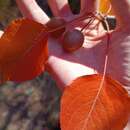Comments
(
Anglèis
)
fornì da eFloras
This species is often used as stock to graft pear cultivars.
- licensa
- cc-by-nc-sa-3.0
- drit d'autor
- Missouri Botanical Garden, 4344 Shaw Boulevard, St. Louis, MO, 63110 USA
Description
(
Anglèis
)
fornì da eFloras
Trees to 5–8 m tall. Branchlets purplish red when young, purplish brown when old, terete, white tomentose when young, glabrous when old, sparsely pale lenticellate; buds narrowly ovoid, apex obtuse; scales tomentose at margin. Stipules caducous, linear-lanceolate, 1–2 mm, membranous, adaxially sparsely tomentose, margin sparsely glandular denticulate, apex acuminate; petiole 2–6 cm, sparsely pubescent or subglabrous; leaf blade elliptic-ovate or narrowly ovate, 6–10 × 3.5–5 cm, sparsely tomentose when young, soon glabrescent, base broadly cuneate, margin serrate, apex long acuminate. Raceme umbel-like, 5–8-flowered; peduncle tomentose when young, soon glabrescent; bracts caducous, linear-lanceolate, 8–11 mm, membranous, adaxially villous, margin entire, apex acuminate. Pedicel 2–2.5 cm, subglabrous. Flowers ca. 3 cm in diam. Hypanthium campanulate, abaxially white tomentose. Sepals triangular-lanceolate, 2–3 mm, adaxially tomentose, margin entire, apex acuminate. Petals white, ovate, 1–1.5 cm, base shortly clawed, apex rounded. Stamens 20, ca. 1/2 as long as petals. Ovary (2- or)3- or 4-loculed, with 2 ovules per locule; styles (2 or)3 or 4, nearly as long as stamens, glabrous basally. Pome brown with pale dots, globose or ovoid, 2–2.5 cm in diam., 3- or 4-loculed; sepals caducous; fruiting pedicel 2–4 cm, glabrous. Fl. Apr, fr. Aug–Sep. 2n = 34*.
- licensa
- cc-by-nc-sa-3.0
- drit d'autor
- Missouri Botanical Garden, 4344 Shaw Boulevard, St. Louis, MO, 63110 USA
Distribution
(
Anglèis
)
fornì da eFloras
Gansu, Hebei, Shaanxi, Shandong, Shanxi, Xinjiang.
- licensa
- cc-by-nc-sa-3.0
- drit d'autor
- Missouri Botanical Garden, 4344 Shaw Boulevard, St. Louis, MO, 63110 USA
Habitat
(
Anglèis
)
fornì da eFloras
Slopes, mixed hillside forests of the Loess Plateau; 100--1200 m.
- licensa
- cc-by-nc-sa-3.0
- drit d'autor
- Missouri Botanical Garden, 4344 Shaw Boulevard, St. Louis, MO, 63110 USA
Pyrus phaeocarpa: Brief Summary
(
Anglèis
)
fornì da wikipedia EN
Pyrus phaeocarpa, the dusky pear or orange pear, is a species of flowering plant in the family Rosaceae, native to the Loess Plateau of northern China. A wide tree reaching at most 7–8 m (23–26 ft) in height, it is hardy to USDA zone 5, or perhaps even zone 4. Its small yellow to brown fruit are edible, and its Autumn foliage is bright orange to orange-red, giving it good potential as an ornamental. Its chloroplast genome shows that it is closely related to Pyrus pashia, the wild Himalayan pear, and it is suspected to be a hybrid of P. betulifolia, the birchleaf pear, P. pyrifolia, the apple pear, and P. ussuriensis, the Manchurian pear.
- licensa
- cc-by-sa-3.0
- drit d'autor
- Wikipedia authors and editors
Pyrus phaeocarpa: Brief Summary
(
vietnamèis
)
fornì da wikipedia VI
Pyrus phaeocarpa là loài thực vật có hoa trong họ Hoa hồng. Loài này được Rehder miêu tả khoa học đầu tiên năm 1915.
- licensa
- cc-by-sa-3.0
- drit d'autor
- Wikipedia tác giả và biên tập viên
褐梨
(
cinèis
)
fornì da wikipedia 中文维基百科
褐梨: Brief Summary
(
cinèis
)
fornì da wikipedia 中文维基百科
褐梨(学名:Pyrus phaeocarpa)为蔷薇科梨属下的一个种。

